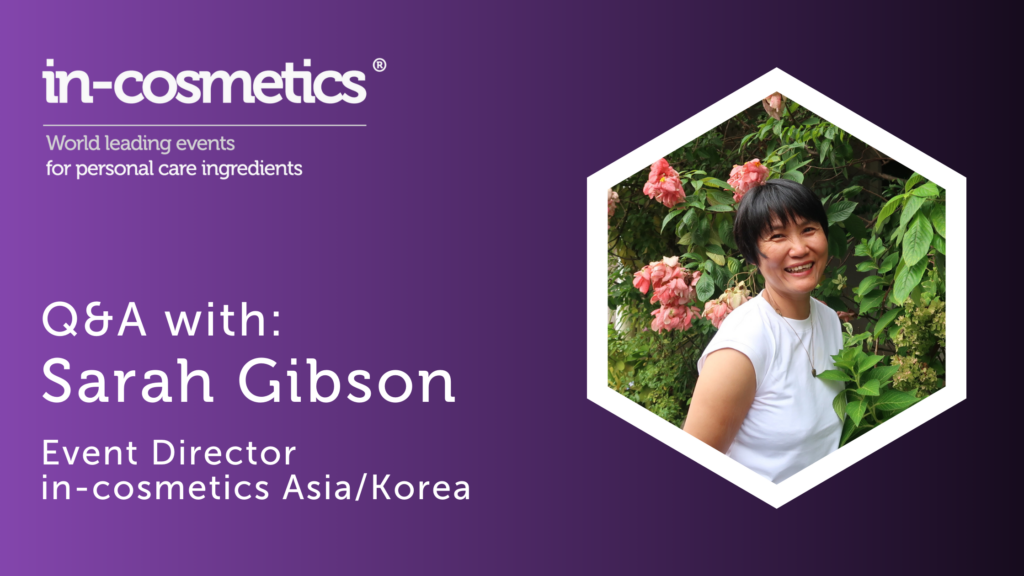
Tell us about yourself…
I call Malaysia home now, but I’m originally from Guangzhou, arguably the most vibrant hub of cosmetic manufacturing in China. It truly feels like destiny led me to in-cosmetics!
Over the past 15 years, I’ve led a truly cosmopolitan team across the Asia Pacific region. My role is as dynamic as it gets, blending elements of strategy, sales, operations and marketing.
During show days, you’ll no doubt spot me walking up and down the aisles, always on the look-out for feedback from our participants.
I particularly enjoy having in-depth conversations with R&D experts to understand where our industry’s heading and finding ways of enhancing the show experience for all.
So next time you see me in Bangkok or Seoul, just say hi and let’s have a chat!
We know Asia Pacific’s beauty and personal care industry is thriving, but can you quantify it for us?
Absolutely! The Asia Pacific region stands as a powerhouse in the beauty and personal care industry, boasting a remarkable 32% share of the global market, surpassing both Europe and North America (*1).
Within this landscape, three inevitable giants emerge: China, Japan, and India. But watch this space…
As an example, the Chinese government has recognized Southeast Asia as a prime business investment destination and is actively promoting trade in the region.
Indonesia, Thailand and Vietnam are booming, making APAC the ultimate destination for anyone serious about thriving in this industry!
What is driving the market in the region?
Western visitors returning to the East after a while are often astonished by the rapid economic development in the region. And this is also reflected in a rise in disposable incomes. I recently read a truly surprising fact mentioning that Asia Pacific is set to surpass North America in consumer spending within the next seven years (*2).
In the wake of the pandemic, we’ve seen a sharp increase in sales of personal hygiene products like shower gel (vs solid soap), sanitizers and hand washes.
Moreover, there’s a growing concern in the region about synthetic chemicals in personal care items, leading more and more consumers to seek “safer” alternatives. This shift fuels market expansion for organic and natural products, though not as pronounced as in the West.
In traditional communities, but also amongst Millennial and Gen Z consumers in APAC, there’s a marked interest in heritage and wellness-based formulations, such as ayurvedic, botanical, and herbal ingredients.
What about skincare?
Despite recent research stating that haircare is the most searched for category in the industry in APAC, (*3), skincare still reigns supreme in the region. Asia Pacific dominates the skincare category on the global market.
And the momentum isn’t slowing down. Away from brightening, skin whitening or moisturizing rituals, in the region the focus is on defying ageing due, in particular, to localized demographics.
With Japan now ranking as the world’s second-oldest population and South Korea unfortunately leading with the lowest fertility rate worldwide, the quest for anti-ageing solutions is more relevant than ever before.
What about the influence of social media in the region?
Going back less than ten years ago, I remember that many personal care suppliers totally dismissed influencers’ impact.
Love them or loathe them, and despite their lack of scientific knowledge in most cases, we all know that influencers can significantly affect the popularity of brands – and ingredients by extension. of course.
Educating them is crucial to prevent backlash, as demonstrated by Dow’s successful influencer workshop at in-cosmetics Asia last year. During that presentation, Dow tackled myths and misconceptions, like those surrounding silicones – which can only be a good thing for all of us.
Asia Pacific leads social media usage. True, with 60% of the world’s population it’s bound to be ranking high. For instance, six out of the top 10 countries for Facebook and Youtube usage are in APAC (*5).
Even LinkedIn, generally less popular in the region, sees high usage, with India and China ranking very high despite the latter blocking the platform, whilst WeChat is indispensable in China.
Any particular market to watch in the region?
We’ve had K-beauty, J-beauty, and C-beauty but now the newest star on the horizon is Thailand, shining brightly with a remarkable 14% surge in market size last year.
This upturn, outperforming all other key APAC markets except Hong Kong, underscores Thailand’s burgeoning influence in the region.
Thailand is where creativity meets entrepreneurship and a dynamic, business-friendly environment. While the majority of brands in Thailand are small to medium-sized, there are also a lot of contract manufacturing facilities operating on behalf of multinationals, from Unilever to J & J.
Internationally, Thai brands are also making inroads. Take beauty brand Mistine for instance, the crown jewel of Better Way. As reported by CosmeticsDesignAsia, Mistine has carved a significant market share in China, emerging as the best-selling sunscreen brand nationwide in 2023.
What sets Thai consumers apart is their enthusiasm for experimentation, making the country an ideal test bed and launchpad in the region for brands and suppliers alike.
What are the challenges to expansion in the region and how can you help?
With diversity comes fragmentation, so understanding the local business culture, language and regulations is key. For exhibitors new to this market, we’ve curated a First-Time Exhibitor package designed to facilitate your entry.
Also, for exhibiting personal care ingredients suppliers at in-cosmetics Asia (Bangkok, 5-7 Nov), we strategically direct visitor traffic to your booth by focusing on established show areas.
Among these, the “Spotlight On Skinscreen” zone serves as a dedicated platform for promoting formulated skincare ingredients, while the renowned “Innovation Zone” (for ingredients launched within eight months of the show) offers a prime opportunity to showcase your latest offering.
The event has seen remarkable growth, with the 2023 edition attracting over 11,700 visitors, with 40% hailing from outside Thailand.
To reach this diverse audience, we run multilingual promotions. This year, this includes launching a Thai website as well as online advertising on Baidu, the Chinese equivalent of Google. We also communicate on WeChat and geo-target posts in Asian languages on Facebook and Instagram amongst others.
The market is thriving, it would be a shame not take advantage of it!
Calling all personal care ingredient suppliers….
Want to make your mark in APAC? Contact your local sales representative today
*1. Source: Euromonitor International
*2. Source: Statista
*3. Source: Covalo
*4: Source: fortunebusinessinsights.com
*5: Source: Statista
Feeling inspired to see ingredients and trends in action?
Then why not visit one of the in-cosmetics events around the world?

